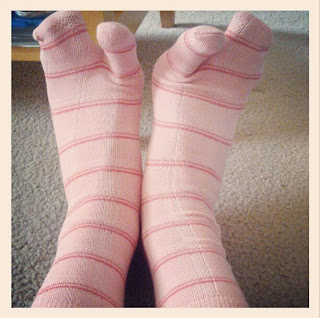Lab Lessons: The Foot
Many times in my life I've had to convert feet to meters or vice versa. The blame is on America, who decides to use the foot over the meter. Such is one of the prices we pay to live in this country (I do love America, in all sincerety, though). Using the foot brings rise to many questions in my head. How tall was Napoleon? What determined the length of a foot? Why can't we all just use the same system? Who decides that 1 foot is equal to 1/3 yard or 12 inches or 0.3048 meters? I went online to investigate. It's sad that I do a lot of my research of these things via the Internet now instead of going to the library. The library isn't always open when I need it, though! Okay. What does the Internet say about the foot (unit)?
According to Wikipedia (Wikipedia's page about the foot), the foot across time and space has ranged from 250 mm to 335 mm. Apparently, there was an international yard and pound agreement of July 1959 (among the United States and the Commonwealth of Nations) that decided 1 yd = 0.9144 meters (and 1 pound = 0.45359237 kilogram.). Since it was decided that 1 yd = 3 ft, then 1 ft = 0.9144/3 meters = 0.3048 meters. Okay. Got it. Treaties solve everything in history, right? Hah.
Going into the depths of history (my most difficult subject in school was history, so bear with me if I get my facts wrong), the Roman foot was about 295mm, close to the size of an actual Roman's foot. After the Roman Empire fell, Charlemagne tried to use the toise de l'Écritoire (fingertip to fingertip of outstretched arms), about 6 feet (of the 326.6mm foot variety, haha). His attempts were unsuccessful, and 296.1mm foot was used until the 10th century (when a foot of 320mm was used).
Even more interesting for establishing the rod in about 1536, Jakob Kobel wrote in Geometrei:
"Stand at the door of a church on a Sunday and bid 16 men to stop, tall ones and small ones, as they happen to pass out when the service is finished; then make them put their left feet one behind the other, and the length thus obtained shall be a right and lawful rood to measure and survey the land with, and the 16th part of it shall be the right and lawful foot."
Of interesting note...
* Under Napoleon, France used to define 1 ft = 1/3 meter
* "Confusion about [Napoleon's] height also results from the difference between the French pouce and British inch—2.71 and 2.54 cm, respectively; he was about 1.7 m (5'7") tall, above average height for the period" -- Wikipedia
* The palm (200 mm - 280 mm) was used instead of the foot in some Mediterranean cities
* J.F.G. Palaiseau grouped length into linear (palms, feet), cloth (ells), and distances traveled (miles, leagues)
According to Wikipedia (Wikipedia's page about the foot), the foot across time and space has ranged from 250 mm to 335 mm. Apparently, there was an international yard and pound agreement of July 1959 (among the United States and the Commonwealth of Nations) that decided 1 yd = 0.9144 meters (and 1 pound = 0.45359237 kilogram.). Since it was decided that 1 yd = 3 ft, then 1 ft = 0.9144/3 meters = 0.3048 meters. Okay. Got it. Treaties solve everything in history, right? Hah.
Going into the depths of history (my most difficult subject in school was history, so bear with me if I get my facts wrong), the Roman foot was about 295mm, close to the size of an actual Roman's foot. After the Roman Empire fell, Charlemagne tried to use the toise de l'Écritoire (fingertip to fingertip of outstretched arms), about 6 feet (of the 326.6mm foot variety, haha). His attempts were unsuccessful, and 296.1mm foot was used until the 10th century (when a foot of 320mm was used).
Even more interesting for establishing the rod in about 1536, Jakob Kobel wrote in Geometrei:
"Stand at the door of a church on a Sunday and bid 16 men to stop, tall ones and small ones, as they happen to pass out when the service is finished; then make them put their left feet one behind the other, and the length thus obtained shall be a right and lawful rood to measure and survey the land with, and the 16th part of it shall be the right and lawful foot."
Of interesting note...
* Under Napoleon, France used to define 1 ft = 1/3 meter
* "Confusion about [Napoleon's] height also results from the difference between the French pouce and British inch—2.71 and 2.54 cm, respectively; he was about 1.7 m (5'7") tall, above average height for the period" -- Wikipedia
* The palm (200 mm - 280 mm) was used instead of the foot in some Mediterranean cities
* J.F.G. Palaiseau grouped length into linear (palms, feet), cloth (ells), and distances traveled (miles, leagues)


Comments
Post a Comment